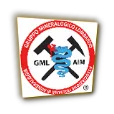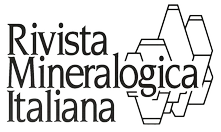Abstract 2020
Rivista Mineralogica Italiana > Abstract Articoli
Abstract ITALIAN MINERALOGICAL MAGAZINE nr. 1-2020 | |||||||||
DUFTITE AND MOTTRAMITE OF EX QUARRY PURICELLI CUASSO AL MONTE (VA) | Since the early 80s of the last century, several arsenic, zinc, copper and lead minerals were found in the greenish greisen facies associated to the granophyre of Cuasso al Monte. They include agardite, adamite, arsenopyrite, hemimorphite, löllingite and mimetite. Duftite and mottramite, copper and lead arsenate and vanadate, respectively, can be added to the list of species of minerals from the miarolitic cavities found so far at Cuasso al Monte. These minerals form microspheres, green in color, consisting of crystalline “rice grains” aggregates coating all the other minerals in the miarolitic cavity. | MINERALS FROM SAPIN VALLEY AND THE PIRAMIDES CALCAIRES IN VENÌ VALLEY (AO) | Mineralogical occurence in the Sapin Valley is located along the slopes of the Tronchey ridges. It is a large talus consisting of limestone rocks with boulders lined by cracks often covered by dolomite crystals up to several centimeters across. During the frequent collecting efforts, albite crystals have rarely been found, as well. The most interesting mi- nerals of this locality are: “adularia” with very aesthetic crystals with edges up to 5 cm on dolomite in association with “apatite”, albite, with white tabular crystals up to 4 cm across in very aesthetic specimens of both single crystals and crystal groups perched atop dolomite crystals, “apatite,” colorless, transparent and highly lustrous crystals up to 5 mm across, calcite, frequently found as whitish or yellowish rounded crystals up to 15 cm in diameter, dolomite as white or brownish rhombohedral crystals up to 5 cm across, associated with “apatite” and quartz in colorless and clear crystals, some of them doubly-terminated, up to 4 cm tall. | ||||||
ARSENATES AND ANTIMONY MINERALS FROM A SECONDARY MINERAL ASSOCIATION FROM PASSO CAMISOLO, INTROBIO (LC), VALTORTA (BG) | In the last century the Passo Camisolo mine was exploited for lead, silver, zinc and baryte. This locality has been locally known for the presence of abundant microminerals, usually lead and copper carbonates, such as azurite and cerussite, some of them found in nice and aesthetic specimens, as well. One of the authors (F. V.) found a very interesting secondary mineral association at Camisolo mine including a large number of Cu, Pb and Zn arsenates and antimonates. Theisite, sabelliite, clinoclase, euchroite and claraite belong to the minerals, remarkable by their rarity and beauty. | BARYTE MINERALIZATIONS WITHIN THE SANDSTONES OF PONTE MODINO (PIEVEPELAGO, MO) | The aim of the following article is to report discovery of a baryte outcrop within a sandstone bank located along the bank of the Rio delle Tagliole stream, in the vicinity of the town of Ponte Mod- ino (Pievepelago, Modena) in February 2018. The area was explored by other collectors in the past (see insert about Renzo Regoli) who had collected fabu- lous specimens of white barite on matrix. They have already been presented during various exhibitions and mineral shows. These specimens probably be- long to the best specimens that the Tus- can-Emilian Apennines can offer. Our discovery 13 years after that of Renzo Regoli is probably a new one, as the sandstone bank does not show any clear signs of previous workings. On several occasions we had the opportunity to collect remarkable specimens of milky white baryte tabular crystals on matrix up to several cm across from this locality. | ||||||
COPPER: RIDISCOVERY OF THE HISTORICAL SITE IN THE POPOGNA RIVER VALLEY (LIVORNO) | The occurence of crystallized speci- mens of native copper from Monti Livornesi was reported by Ugolini in the 1930s. A further specimen, 1 kg in weight, was found later, probably in the 1950s. Since then, mineral collectors have found no additional specimens of native copper, because location of the original find was lost. Critical examination of the Ugolini’s report has revealed important data which enabled the original locality being rediscovered in 2018. Field work at this locality has lead to a find of crystallized copper specimens. Copper occurs as compact masses or, more rarely, as dendrites formed by dis- torted octahedral crystals, embedded in calcite veins. Other minerals, occurring in this assembly, are anilite, atacamite, connellite, cuprite, and malachite. | ||||||||
Abstract ITALIAN MINERALOGICAL MAGAZINE nr. 2-2020 | |||||||||
THE MINERALS OF VALBONA MINE AND ZUCCO DI CAM: AN ARSENATES-RICH MINERALIZATION IN BIANDINO VALLEY (INTROBIO, VALSASSINA, LC) | Valbona mine, located in a tributary valley of Val Troggia, represents an almost unknown mineralogical site. Valbona is located in the heart of the intrusive body of Val Biandino Quarzodiorites, and is characterized by wild landscapes dominated by high rock walls and by dense bushes of wild rho- dodendrons. This locality is known for a large number of arsenates of Fe, Cu, Pb and Zn, also accompanied by minor phosphates and sulphates. Here there were also found some very interesting minerals for the Italian mineralogy, such as philipsbornite (the second Italian occurrence), and gilalite (the fourth world´s occurrence). | MINERALS FROM VOLCANITES AND BASALTS OF PACHINO (SR) | An interesting submarine volcanic formation outcrops at Capo Passero, in the southeastern Sicily. It covers an area of about 25 km2 and consists of hyaloclastites, pillow-lavas, compact lava-flows and a great number of small dykes within hyaloclastites. This paper reports three findings performed in the municipality of Pachino. The first one occurred in the Carrubella quarry, where calcite and augite were observed in a strongly altered volcanite. A second finding was performed during the drilling activity (aimed at finding an aquifer); calcite, phillipsite-K, pyrite and smectite group minerals were collected within a basaltic breccia, whereas in the upper part of the drilled section augite and forsterite were found in basalt. Finally, augite, forsterite and augite were collected at Acqua Palomba. | ||||||
CELESTINE: A CLASSIC OF MADAGASCAR MINERALOGY | The Sakoany celestine deposit is located along the northwest coast of Madagascar, near the estuary of the Betsiboka river, one of the largest rivers on the island, south of the city of Majunga, in the province of Mahajanga. The deposit is located on the coast, at the sea level and extends for about 10 km2. The name Sakoany derives from a small village of no more than 150 in habitants, belonging to the ethnic group of the Sakalava tribe. Celestine is found in concretions isolated from each other within a sedimentary formation of marly-sandy composition of the lower Paleocene age. The thickness of the celestine-rich horizontal stratum is about 30 meters. The extraction of Sakoany celestine geodes takes place using hand instruments and rudimentary techniques. The exploitation of the mineralized sedimentary unit is limited to the top by the alteration band and at the bottom by reaching the aquifer. The geodes are generally extracted complete, brought to the village of Sakoany and then opened with great caution, with the aim not to damage the crystals. Broadly speaking, the most recurrent crystalline morphologies can be divided into three categories: (1) short prismatic, thick crystals; (2) elongated prismatic crystals; (3) elongated bipyramidal crystals. In the past, Sakoany‘s geodes were split more or less in the middle or opened on one side and then marketed. In more recent times, suitable laboratory preparation is generally carried out for the most beautiful specimens following the requirements of the advanced collectors. | ||||||||
UVAROVITE AND OTHER MINERALS FROM THE PRAE QUARRY MONTE SANT’AGATA FRAMURA (SP)  | This paper reports the results of mineralogical researches conducted by the authors for about thirty years at the Prae quarry, Framura, in the province of La Spezia. In this quarry, some activities were carried out for the re search and extraction of cupriferous pyrite in the past, while today the extracted material is used for the production of rock-fall barriers and other geo-technical use. The minerals have been found within ophiolitic rocks, mainly represented by gabbro. In this quarry the most interesting minerals are anal- cime, clinozoisite, “heulandite”, natrolite, pyrite, prehnite and uvarovite. | ||||||||
Abstract ITALIAN MINERALOGICAL MAGAZINE nr. 3-2020 | |||||||||
APOPHYLLITE AND PREHNITE IN THE METAGABBRO OF BONASSOLA, LA SPEZIA | The locality described in this work provided some of the best crystallized prehnite specimens of the entire Ligurian region. Color of these well de- veloped crystals vary from colorless to pale green, with a pseudocubic to prismatic habit, sometimes with a typical termination. Other associated minerals in the cavities of metagabbro are “pumpellyite”, hornblende and “apophyllite”. “Apophyllite” occurs in milky white to colorless crystals, up to two millimeters in length with pris- matic habit and rounded edges. | BARYTE FROM SASSO ROSSO, GRIZZANA MORANDI (BO) | More than forty years ago, baryte was found in the Sasso Rosso hydrother- malite, close to the Mozzana Creek (Grizzana Morandi, Bologna). This find has remained unique in the Northern Apennines. This paper de- scribes and illustrates several samples of baryte collected at Sasso Rosso in the early 1980s. Baryte crystallized on lenticular dolomite and shows a characteristic pseudo-cubic or pseu- do-rhombohedral habit; in some cases, a prismatic habit has been observed, due to the crystal elongation along the zaxis. | ||||||
COTUNNITE FROM TAVAGNASCO MINES, TAVAGNASCO (TO) | This short article aims to highlight the find of cotunnite at Rosa Superiore tunnel at Tavagnasco mines (Turin Province, Piedmont, Italy). This uncommon species occurs as rounded yellow rhombohedral crystals up to 800 μm in size, significantly large for the species, and perched atop iron oxide-coated quartz crystals. Cotunnite was found in 2012 by one of the authors (G.P.) in a small geode. Using the hypothesis, explaining the presence of chlorine, confirmed by the find of mimetite in the same and neigh- bouring adits, the authors concluded that cotunnite from Tavagnasco is of natural origin and not of anthropogen- ic nature. The find is the first one for the region of Piedmont and among the first ten reported in Italy. | TINNUNCULITE RHABDOPHANE-(LA), PARNAUITE, HINGGANITE-(Y), FETIASITE AND OTHER MINERALOGICAL NOVELTIES FROM MOUNT CERVANDONE (DEVERO VALLEY, VB) | Following the big effort of few local mineral researchers and collectors, including Enzo Sartori and Vittorio Soldani who did their utmost to recover new material for analysis, identification of minerals from Mount Cervandone has continued and new discoveries have been made in the last ten years. The article therefore describes a number of minerals previously nev- er reported at Mount Cervandone; others, already known, are characterized through new data, morpholog- ical descriptions, mineralogical associations and excellent photographs in order to help the mineral collec- tors of this locality in identifying some species which, in general, are not easy to recognize. The article describes interesting mineralogical nov- elties found in recent years including some of them being new for Mount Cervandone. They include tinnunculite, rhabdophane-(La), parnauite, and hingganite-(Y). For other minerals studied, but already known at this locality, new data, morphologi- cal descriptions and excellent photographs are provided to help mineral collectors in their recognition. These latter include fetiasite, carbonatocy- anotrichite, synchysite-(Ce), gaspar- ite-(Ce) and strashimirite. | ||||||
TOURMALINES FROM THE NORTH KIVU PROVINCE DEMOCRATIC REPUBLIC OF CONGO | In recent years, tourmaline crystals of exceptional transparency, luster and wide variety of colors from Congo have begun to show up at the international mineral market. The place of discovery (known as the Rubaya deposit) is lo- cated in the north-east of the country (North Kivu Province), on the border with Rwanda, in an area plagued by strong ethnic and political tensions. In fact, in IPIS (2016), the place now known as Rubaya (from the name of the homonymous town, located alongthe access road to the area coming from the city of Goma) has been reported as the site of Rwangara/Shakubangwa, at the altitude of 2,719 meters above sea level. The only data available to date about the chemical composition of these tourmalines are those reported by Laurs et al. (2017), in which the tourmalines studied from Rubaya appear to be elbaite, with a modest liddicoatite component and with iron and manga- nese as main chromophores. From a morphological point of view, different fortunately, most of the extracted material is damaged directly on the excavation face by the miners who are focused only on the search for gem rough, precluding the possibility of obtaining matrix specimens. | ||||||||
IRON NAILS COATED BY GOLD, A GREAT CLASSIC OF LIGURIAN MINERALOGY FROM THE LIBIOLA MINE | The Libiola mine (Sestri Levante, Genova) had been one of the most important Italian copper mines. In addition to the well-known specimens of native copper, silver, gypsum, and botryogen, extremely rare iron nails coated by gold, found in the Weirs tunnel of the Libiola mining complex, as well as on the old dumps belong to the classic finds from this locality. The origin of this gold coating is likely due to electrochemical processes. | ||||||||
Abstract ITALIAN MINERALOGICAL MAGAZINE nr. 4-2020 | |||||||||
FLUORAPOPHYLLITE-(K) FROM THE SISSONE VALLEY (MALENCO VALLEY, SO) | This article presents chemical data and the crystal lattice parameters ob- tained through the study of fluorap- ophyllite-(K) from the Sissone Valley found by Ivano and Samuele Foianini. A careful bibliographic search on the “apophyllite” from Sissone valley confirms that high quality specimens of fluorapophyllite-(K) similar to those described in this article were never found before in the Malenco area. They represent a unique, excep- tional find, which will remain part of the history of Valtelline mineralogy. | QUARTZ FROM THE EVAPORITES OF THE UPPER SECCHIA VALLEY (RE) | In the upper valley of the Secchia river (Reggio Emilia, Italy), black quartz crystals embedded in banks of white saccharoidal gypsum have long been known. Quartz crystals were formed here within Upper Triassic evaporite deposits. These quartz crystals can be found enclosed in the rock that hosts them and completely envelopes them. Their crystallization took place at a depth of about 8-10 km during the Oligocene and Miocene age, about 20 million years ago, during the Apen- nine orogeny. The size of the quartz crystals varies from few millimeters to about 5 centimeters across. Their black color is caused by the inclusions of bituminous substances. However, colorless crystals can sometimes be found, as well. Crystals are always doubly terminated and show a simple combination of the prism and two direct and inverse rhombohedra. | ||||||
KYANITE AND PYROPHYLLITE FROM MONTE BRUGIANA (MS) | Good specimens of kyanite and py- rophyllite have been collected in Carnian metasedimentary rocks (phyllite, quartzite, and metaconglomerates) in the Monte Brugiana area (Massa-Carrara, Tuscany, Italy). These minerals typically occur at the contact between quartz veins and phyllite. Kyanite forms aggregates of prismatic-tabular crystals, light blue to grey in color, up to several centimeters long (exceptionally up to 15 cm, as in some specimens collected in the Canale di Bedizzano). Pyrophyllite occurs as rosette like aggregates, few mm in diameters, and only rarely as distinct prismatic mm-sized crystals. | THE SULFIDES-BEARING VEINS FROM VALSASSINA (LECCO): GENESIS OF THE VEINS SYSTEM AND COPPER MINERALIZATIONS FROM PRIMALUNA | The sulfides-bearing hydrothermal veins of Valsassina (LC) and Stabina Valley (Valtorta, BG) have long been considered as hydrothermal manifestations directly linked to the intrusive bodies of Val Biandino Quartz-diorite and San Biagio Valley Granite. In the graduation thesis of one of the authors (F.V.), it was highlighted that these veins have instead the classical and distinctive characteristics of the five-element veins type. More over, the genetic model proposed for the five element veins is completely compatible with the geological features present in Valsassina during the Permian, and it can explain all the characteristics observed for the Valsassina veins. The characteristics of the sulfides-bearing hydrothermal veins of Valsassina are discussed, also proposing a possible genetic model, in the first part of this article. In the second part of the article, instead, the cupriferous veins of Primaluna are treated, in particular from a purely mineralogical point of view. In these veins it is possible to observe a par- ticular association of copper min- erals, dominated by the presence of chrysocolla, allophane, malachite and brochantite. These minerals some times occur in truly remarkable samples. More over, in the filling material of an ancient tunnel the presence of mottramite in small yellow crystals on chrysocolla and allophanes has been sporadically observed. | ||||||




















